Ankaa, designated as Alpha Phoenicis, is the brightest star in the constellation of Phoenix, the cosmic firebird.
Key Facts & Summary
- Ankaa is located at around 85 light-years / 26 parsecs away from the Sun.
- It is a single star in the night sky which is visible to the naked eye.
- This star has an apparent magnitude of 2.377 and an absolute magnitude of 0.52.
- Ankaa is a luminous giant star of spectral type K0.5 lllb.
- It is a spectroscopic binary star system with two components.
- This star is outshined by its brighter neighboring stars, such as Achernar and Fomalhaut.
- Ankaa has between 2 to 3 solar masses and 15 solar radii. It is much more massive and bigger than our Sun.
- Ankaa is however, cooler than our Sun, having surface average temperatures of around 4,436 K.
- The surface gravity on this star has been measured at around 2.53 cgs.
- Its rotational velocity is currently unknown, however, its radial velocity has been estimated at +74.6 km / 46.3 mi per second.
- Ankaa is the 84th brightest star in the night sky, on average.
- It is situated between the bright stars Achernar and Fomalhaut, and together, they form a large triangle.
- One can use Ankaa as a guide to find several deep-sky objects in Phoenix.
- Some of these deep-sky objects include the spiral galaxy NGC 300, or the Magellanic-type barred spiral galaxy NGC 55, which is also known as the Whale Galaxy.
- Phoenix is a southern constellation, and it is part of a group of 11 constellations that were depicted by the famous German astronomer Johann Bayer.
- The entire constellation of Phoenix is visible at latitudes 32oN and 80oS.
α Phoenicis
Ankaa, designated as Alpha Phoenicis, is the most prominent star located in the constellation of Phoenix, the mythical firebird. It bore the name Ankaa since 1800, and it derives from the Arabic “al-anqa” which translates to “the phoenix”.
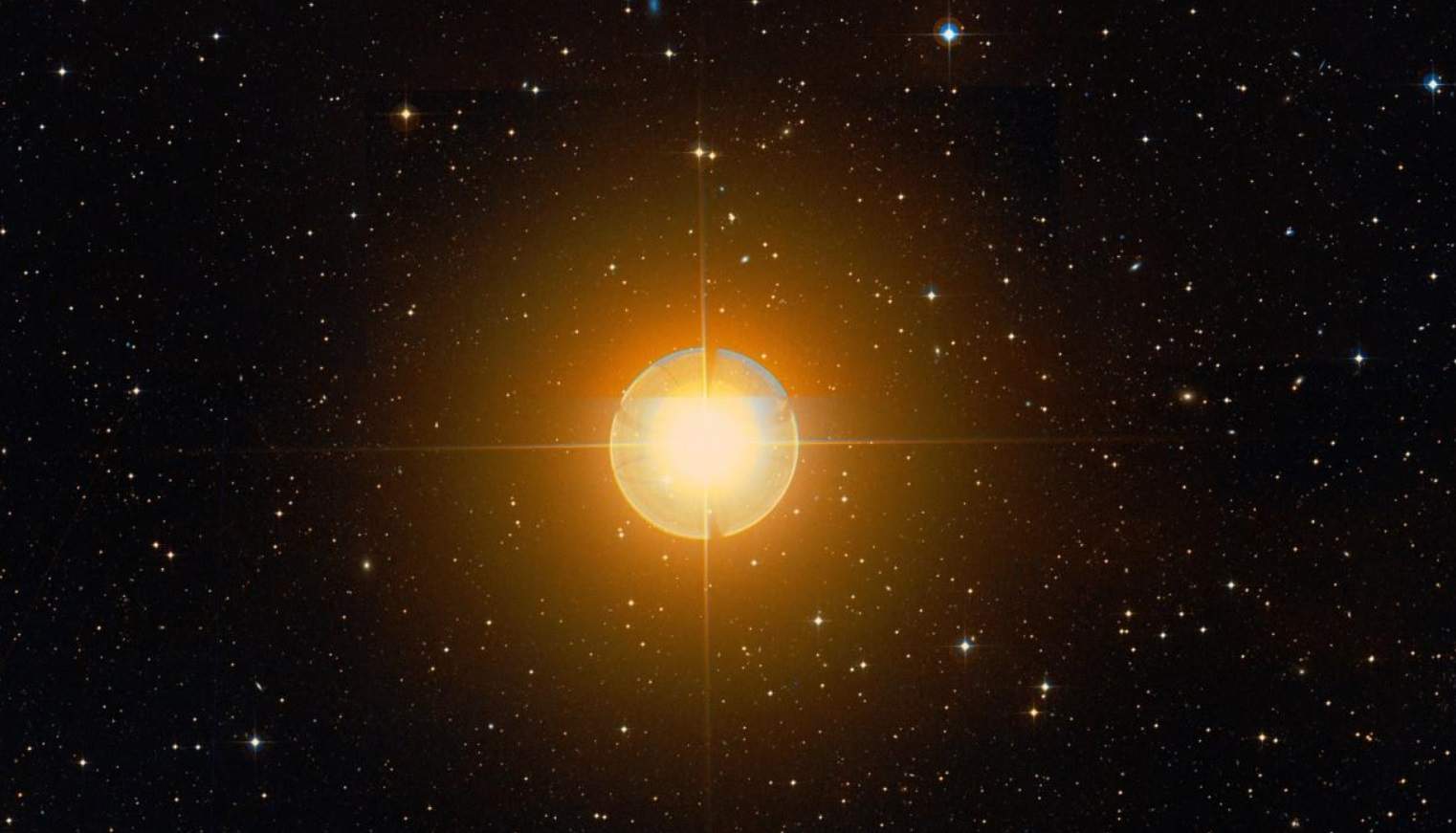
Another name for this star is “Nair al Zaurak” which translates to “the bright star of the skiff”. The Latin name for Alpha Phoenicis is “Cymbae”, deriving from “lucida cumbae”. In 2016, the IAU officially approved the name Ankaa for Alpha Phoenicis.
Formation
The exact age of Ankaa / Alpha Phoenicis is currently unknown. However, this star formed as many others from an interstellar medium of gas and dust.
Gravity pulled the swirling gas and dust together, and resulted in the brightest star of the constellation of Phoenix, Ankaa.
Distance, Size, and Mass
Ankaa is located at around 85 light-years / 26 parsecs away from the Sun. It appears as a single star in the night sky which is visible to the naked eye, however it is a spectroscopic binary star.
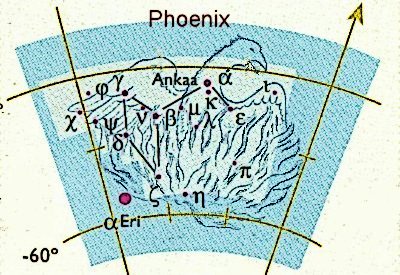
Ankaa has between 2 – 3 solar masses, or 200% to 300% of our Sun’s mass, and around 15 solar radii, or 1,500% of our Sun’s radius. This means that Ankaa is around 30 times bigger than our Sun.
Other Characteristics
Ankaa is a luminous orange giant star of spectral type K0.5 lllb. It is, however, cooler than our Sun, having surface average temperatures of around 4,436 K. Our Sun has around 5,778 K.
Ankaa is outshined by its brighter neighboring stars, such as Achernar and Fomalhaut. This star has an apparent magnitude of 2.377 and an absolute magnitude of 0.52.
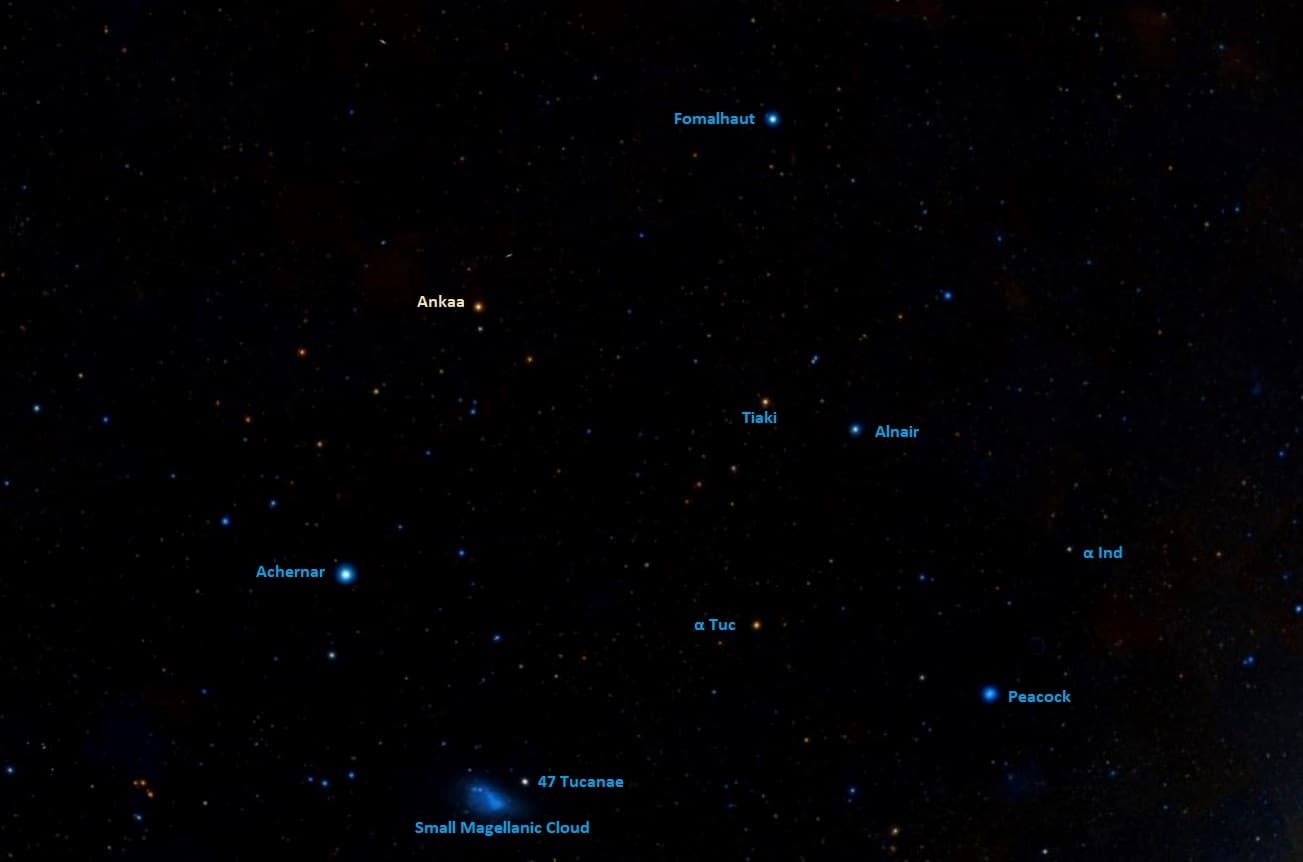
The surface gravity on Ankaa has been measured at around 2.53 cgs. Its rotational velocity is currently unknown; however, its radial velocity has been estimated at +74.6 km / 46.3 mi per second. Ankaa is the 84th brightest star in the night sky, on average.
Stellar System
Ankaa is a spectroscopic binary star system. It is composed out of two stars which orbit one another once every 10.5 years / 3,858 days. These stars are separated by about 103.5 milliarcseconds, which is the equivalent of 7 AU. One AU is the distance from Earth to the Sun.
Location
Ankaa is located in the constellation of Phoenix, the mythical firebird. It is the brightest star in this constellation. With its neighbors, Achernar (constellation of Eridanus) and Fomalhaut (constellation of Piscis Austrinus), Ankaa forms a celestial triangle.
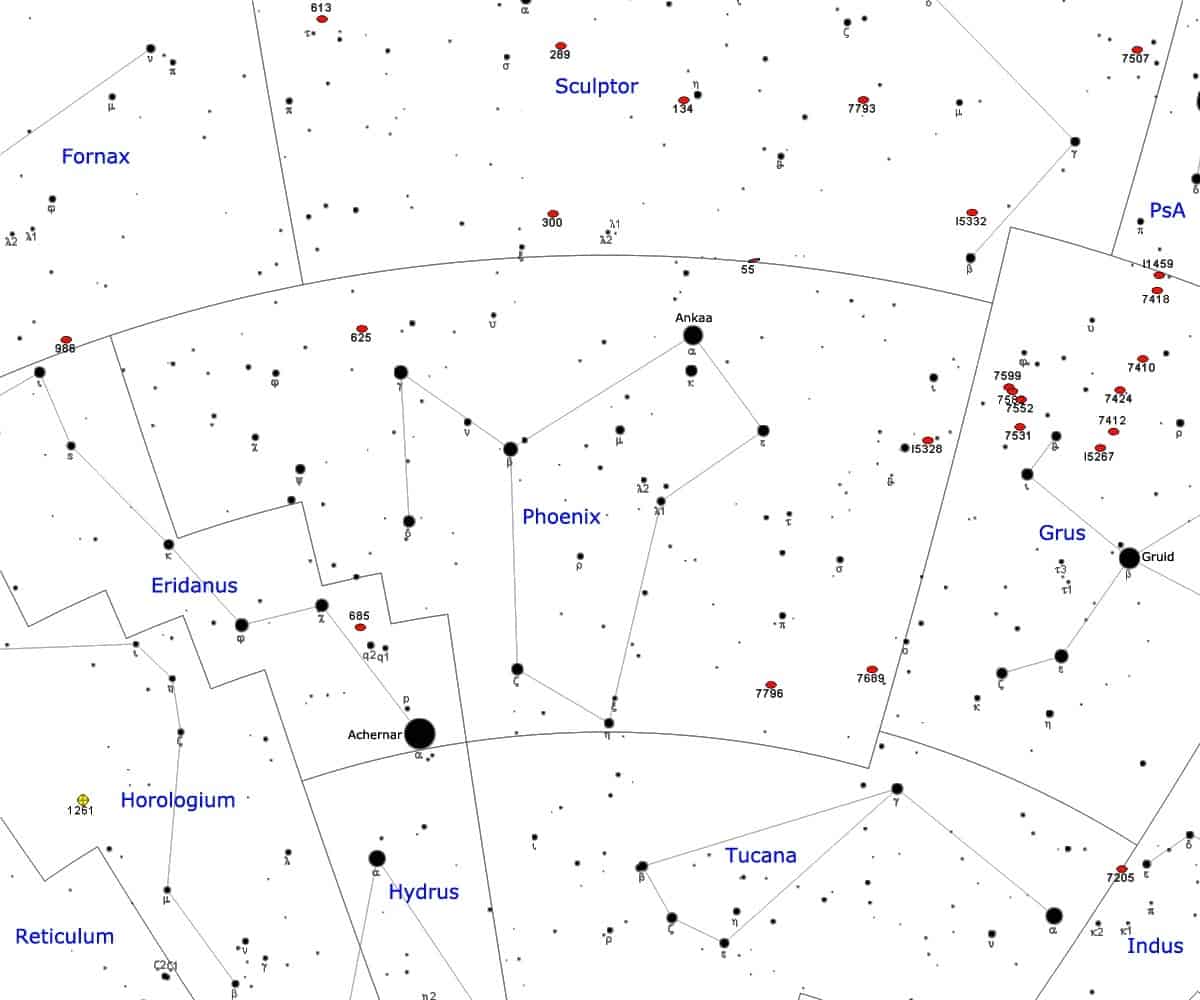
Achernar appears in the same region of sky where the brighter Achernar and Fomalhaut reside. You can use Ankaa to find interesting deep-sky objects.
For example, the bright spiral galaxy NGC 300 (magnitude 9) is located in the northeast of Ankaa. Another bright galaxy, the Magellanic-type barred spiral galaxy NGC 55 (magnitude 7.87), known as the Whale Galaxy, is located northwest of Ankaa.
Phoenix is a southern constellation, and it is part of a group of 11 constellations that were depicted by the famous German astronomer Johann Bayer, but created by Petrus Plancius in the late 16th century.
The entire constellation of Phoenix is visible at latitudes 32oN and 80oS. It is the 37th largest constellation in the sky, stretching for about 469 square degrees.
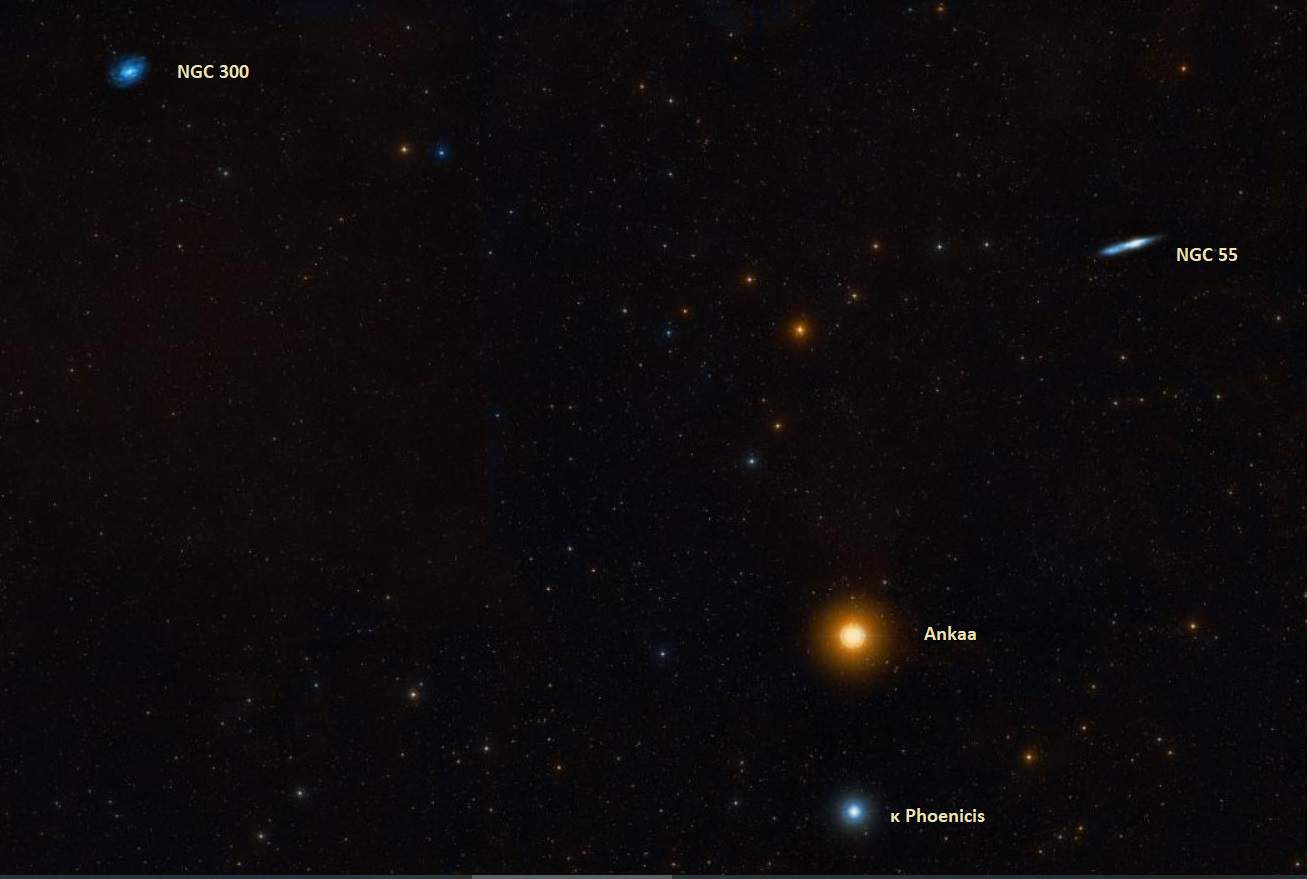
The constellation of Phoenix hosts many interesting deep-sky objects, such as the irregular dwarf galaxy NGC 625, the lenticular galaxy NGC 37, the group of galaxies known as Robert’s Quartet, the HLX-1 luminous source, which is the first discovered intermediate black hole, the gigantic Phoenix Cluster, or the largest distant galaxy cluster ever observed, the El Gordo, among others.
The best time to observe Ankaa / Alpha Phoenicis, and the other bright stars and deep-sky objects of Phoenix,is during the month of November, when it is the most prominent.
The top ten brightest stars in Phoenix are:
- Ankaa – magnitude 2.3
- Beta Phoenicis – magnitude 3.30
- Gamma Phoenicis – magnitude 3.41
- Epsilon Phoenicis – magnitude 3.87
- Kappa Phoenicis – magnitude 3.94
- Delta Phoenicis – magnitude 3.93
- Wurren / Zeta Phoenicis – magnitude 3.9 – 4.44
- Eta Phoenicis – magnitude 4.36
- Psy Phoenicis – magnitude 4.3 – 4.5
- Mu Phoenicis – magnitude 4.59
The Future
Ankaa, like all stars, will one day end its life. However, this star is not massive enough to go nova. It will end its life cycle by casting away its outer layers, and then it will slowly fade away as a faint white dwarf star.
Did you Know?
- Ankaa is the only star in Phoenix which is part of the famous 58 navigational stars. Only the brightest and the most easily recognizable stars are part of this group of stars.
- Ankaa is almost as bright as Merak (constellation of Ursa Major), Izar (constellation of Bootes), Enif (constellation of Pegasus), and Girtab (constellation of Scorpius).
- Ankaa is brighter than Phecda (constellation of Ursa Major), Sabik (constellation of Ophiuchus), Scheat (constellation of Pegasus), and Aludra (constellation of Canis Major).
- The Chinese know Ankaa / Alpha Phoenicis as Huo Diao liu – which means the Sixth Star of Firebird – the Firebird is a Chinese asterism formed by Ankaa, Iota, Sigma, Epsilon, Kappa, Mu, Lambda, Beta, and Gamma Phoenicis.
Sources:
Image Sources:
- https://www.star-facts.com/wp-content/uploads/2020/09/Ankaa.jpg?189db0&189db0
- https://www.constellationsofwords.com/images/stars/ankaa.JPG
- https://www.star-facts.com/wp-content/uploads/2020/09/Ankaa-location.jpg?189db0&189db0
- https://www.star-facts.com/wp-content/uploads/2020/09/Phoenix-constellation.jpg?189db0&189db0
- https://www.star-facts.com/wp-content/uploads/2020/09/Ankaa-NGC-55-and-NGC-300.jpg?189db0&189db0
